Mordechai Segev
Time-Reflection of Microwaves by a Fast Optically-Controlled Time-Boundary
Oct 03, 2023Abstract:When an electromagnetic (EM) wave is propagating in a medium whose properties are varied abruptly in time, the wave experiences refractions and reflections known as "time-refractions" and "time-reflections", both manifesting spectral translation as a consequence of the abrupt change of the medium and the conservation of momentum. However, while the time-refracted wave continues to propagate with the same wave-vector, the time-reflected wave is propagating backward with a conjugate phase, despite the lack of any spatial interface. Importantly, while time-refraction is always significant, observing time-reflection poses a major challenge - because it requires a large change in the medium occurring within a single cycle. For that reason, time-reflection of EM waves was observed only recently. Here, we present the observation of microwave pulses at the highest frequency ever observed (0.59 GHz), and the experimental evidence of the phase-conjugation nature of time-reflected waves. Our experiments are carried out in a periodically-loaded microstrip line with optically-controlled picosecond-switchable photodiodes. Our system paves the way to the experimental realization of Photonic Time-Crystals at GHz frequencies.
Phase Retrieval of Vortices in Bose-Einstein Condensates
Nov 21, 2022Abstract:We propose and demonstrate numerically a measurement scheme for complete reconstruction of the quantum wavefunctions of Bose-Einstein condensates, amplitude and phase, from a time of flight measurement. We identify a fundamental ambiguity present in the measurement of vortices and show how to overcome it by augmenting the measurement to allow reconstruction of matter-wave vortices and arrays of vortices.
Deep learning reconstruction of ultrashort pulses from 2D spatial intensity patterns recorded by an all-in-line system in a single-shot
Nov 23, 2019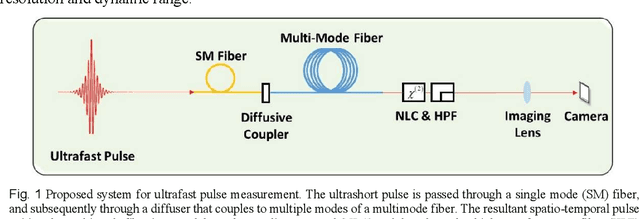
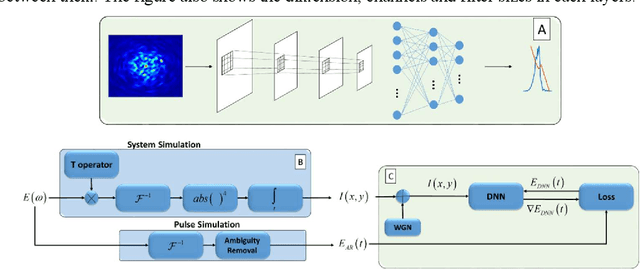
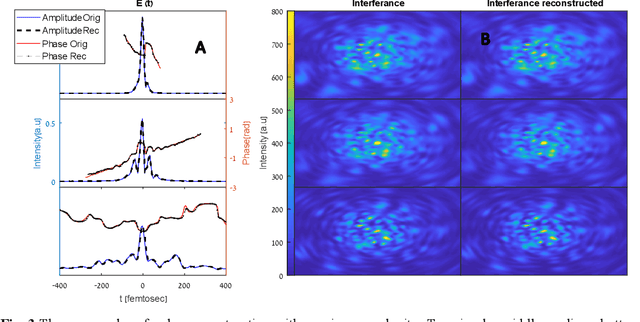
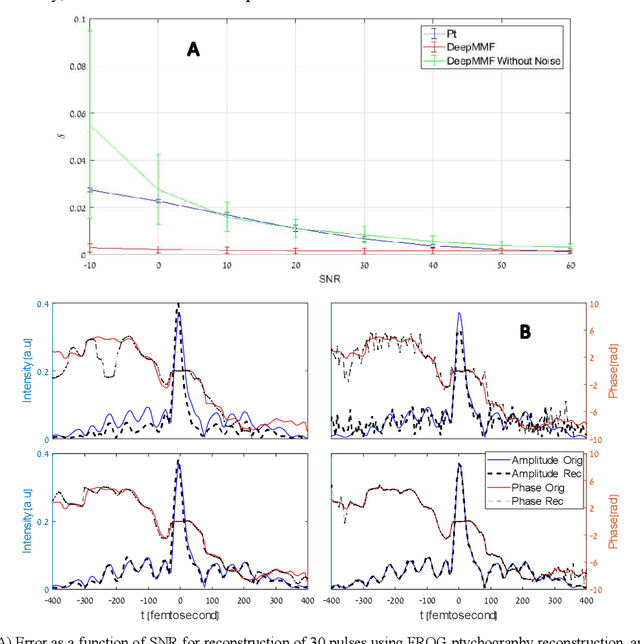
Abstract:We propose a simple all-in-line single-shot scheme for diagnostics of ultrashort laser pulses, consisting of a multi-mode fiber, a nonlinear crystal and a CCD camera. The system records a 2D spatial intensity pattern, from which the pulse shape (amplitude and phase) are recovered, through a fast Deep Learning algorithm. We explore this scheme in simulations and demonstrate the recovery of ultrashort pulses, robustness to noise in measurements and to inaccuracies in the parameters of the system components. Our technique mitigates the need for commonly used iterative optimization reconstruction methods, which are usually slow and hampered by the presence of noise. These features make our concept system advantageous for real time probing of ultrafast processes and noisy conditions. Moreover, this work exemplifies that using deep learning we can unlock new types of systems for pulse recovery.
Deep Learning Reconstruction of Ultra-Short Pulses
Mar 15, 2018
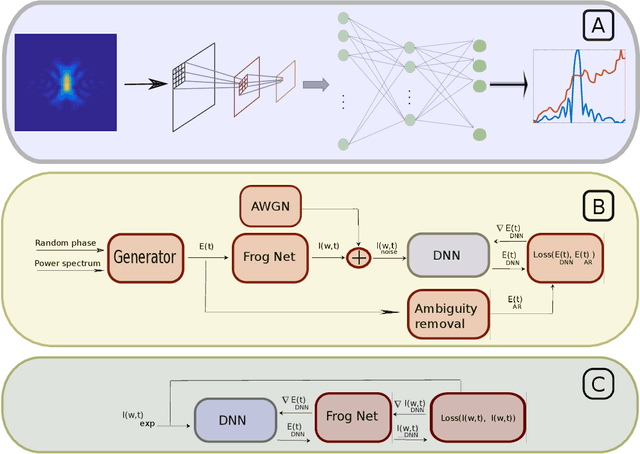


Abstract:Ultra-short laser pulses with femtosecond to attosecond pulse duration are the shortest systematic events humans can create. Characterization (amplitude and phase) of these pulses is a key ingredient in ultrafast science, e.g., exploring chemical reactions and electronic phase transitions. Here, we propose and demonstrate, numerically and experimentally, the first deep neural network technique to reconstruct ultra-short optical pulses. We anticipate that this approach will extend the range of ultrashort laser pulses that can be characterized, e.g., enabling to diagnose very weak attosecond pulses.
Sparsity-Based Super Resolution for SEM Images
Aug 29, 2017

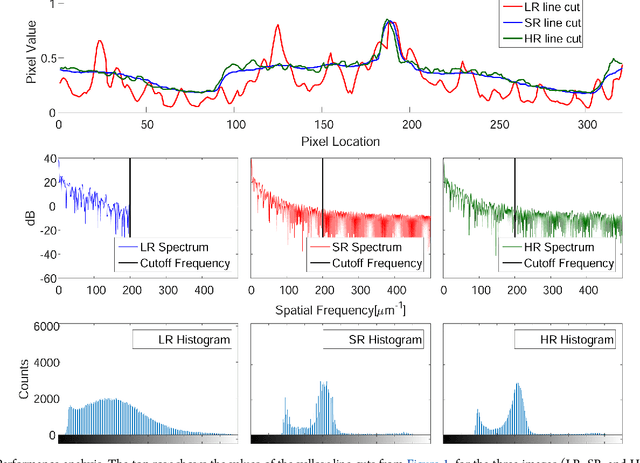
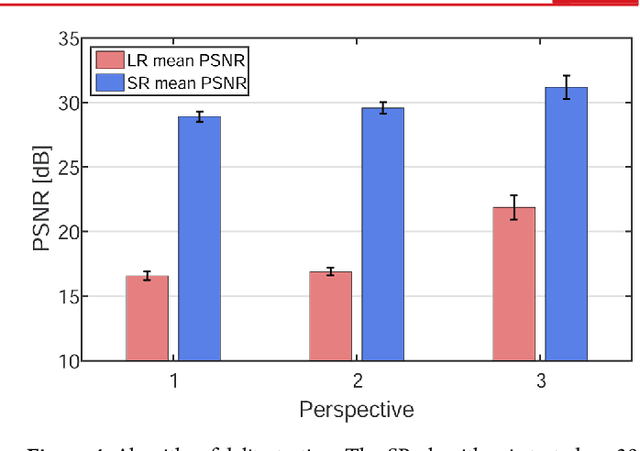
Abstract:The scanning electron microscope (SEM) produces an image of a sample by scanning it with a focused beam of electrons. The electrons interact with the atoms in the sample, which emit secondary electrons that contain information about the surface topography and composition. The sample is scanned by the electron beam point by point, until an image of the surface is formed. Since its invention in 1942, SEMs have become paramount in the discovery and understanding of the nanometer world, and today it is extensively used for both research and in industry. In principle, SEMs can achieve resolution better than one nanometer. However, for many applications, working at sub-nanometer resolution implies an exceedingly large number of scanning points. For exactly this reason, the SEM diagnostics of microelectronic chips is performed either at high resolution (HR) over a small area or at low resolution (LR) while capturing a larger portion of the chip. Here, we employ sparse coding and dictionary learning to algorithmically enhance LR SEM images of microelectronic chips up to the level of the HR images acquired by slow SEM scans, while considerably reducing the noise. Our methodology consists of two steps: an offline stage of learning a joint dictionary from a sequence of LR and HR images of the same region in the chip, followed by a fast-online super-resolution step where the resolution of a new LR image is enhanced. We provide several examples with typical chips used in the microelectronics industry, as well as a statistical study on arbitrary images with characteristic structural features. Conceptually, our method works well when the images have similar characteristics. This work demonstrates that employing sparsity concepts can greatly improve the performance of SEM, thereby considerably increasing the scanning throughput without compromising on analysis quality and resolution.
 Add to Chrome
Add to Chrome Add to Firefox
Add to Firefox Add to Edge
Add to Edge